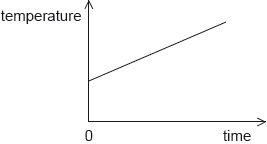| Date | May 2019 | Marks available | 4 | Reference code | 19M.2.SL.TZ1.4 |
| Level | Standard level | Paper | Paper 2 | Time zone | 1 |
| Command term | Determine | Question number | 4 | Adapted from | N/A |
Question
A tube of constant circular cross-section, sealed at one end, contains an ideal gas trapped by a cylinder of mercury of length 0.035 m. The whole arrangement is in the Earth’s atmosphere. The density of mercury is 1.36 × 104 kg m–3.
When the mercury is above the gas column the length of the gas column is 0.190 m.
The tube is slowly rotated until the gas column is above the mercury.
The length of the gas column is now 0.208 m. The temperature of the trapped gas does not change during the process.
A solid cylinder of height h and density ρ rests on a flat surface.
Show that the pressure pc exerted by the cylinder on the surface is given by pc = ρgh.
Show that (po + pm) × 0.190 = where
po = atmospheric pressure
pm = pressure due to the mercury column
T = temperature of the trapped gas
n = number of moles of the trapped gas
A = cross-sectional area of the tube.
Determine the atmospheric pressure. Give a suitable unit for your answer.
Outline why the gas particles in the tube hit the mercury surface less often after the tube has been rotated.
Markscheme
weight of cylinder = Ahg ρ ✔
pressure = = ✔
Allow use of A = in MP1.
use of PV = nRT and V = Area × (0.190) seen ✔
substitution of P = po + pm «re-arrangement to give answer»✔
recognition that is constant OR 190po + 190pm = 208po − 208pm
OR po = pm ✔
pressure due to mercury pm = 0.035 × 1.36 × 104 × 9.81(= 4.67 × 103 Pa) ✔
1.03 × 105 ✔
Pa OR Nm-2 OR kgm-1s-2 ✔
Do not award for a bald correct answer. Working must be shown to award MP3.
Award MP4 for any correct unit of pressure (eg “mm of mercury / Hg”).
same number of particles to collide with a larger surface area OR greater volume with constant rms speed decreases collision frequency ✔
Look for a correct statement that connects pressure to molecular movement/collisions.
Examiners report
This question was fairly well answered with a not insignificant number of candidates making clearly wrong substitutions (such as F=mgh) to make the equation work out. As a “show that” question the derivation should be neatly laid out with the fundamental equations written out and the substitutions/cancelations clearly shown.
This question was generally well answered. Most candidates took the time to show the set up and substitutions they used to derive the given expression. A small number of candidates attempted to “show that” by making unit substitutions - this is not acceptable for a question like this.
This question was left blank by many candidates. Of those who attempted a solution, few appreciated the difference made to the derived equation from 4bi when the tube was rotated. It should be noted that this was also the “unit question” on this exam, and a candidate could have been awarded a mark for clearly writing any correct unit of pressure without doing any calculations. Candidates should be reminded to keep an eye out for this opportunity and to at least write a unit even if the question seems unapproachable.
This was generally poorly answered with the candidates split between answers that generally demonstrated some good understanding of physics (such as connecting the increase in volume AND constant rms speed of particles with the rate of collisions with the mercury) and answers that did not (such as gases want to rise so the gas it will hit the mercury less).


